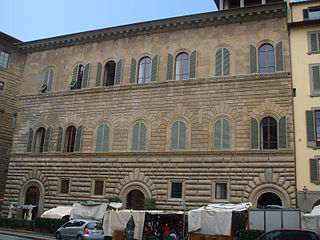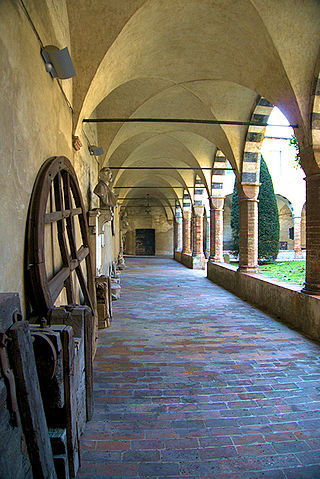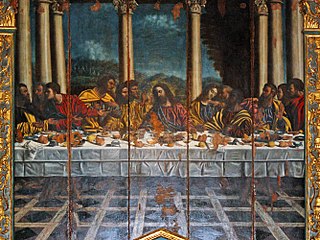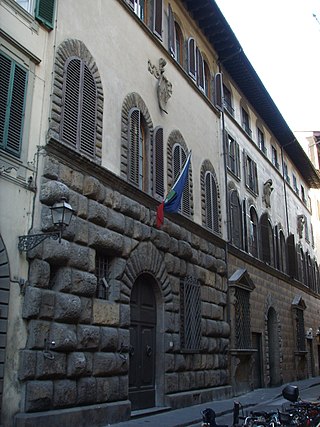
The Palazzo Ducale di Mantova is a group of buildings in Mantua, Lombardy, northern Italy, built between the 14th and the 17th century mainly by the noble family of Gonzaga as their royal residence in the capital of their Duchy. The buildings are connected by corridors and galleries and are enriched by inner courts and wide gardens. The complex includes some 500 rooms and occupies an area of c. 34,000 m2, which make it the sixth largest palace in Europe after the palaces of the Vatican, the Louvre Palace, the Palace of Versailles, the Royal Palace of Caserta and the Castle of Fontainebleau. It has more than 500 rooms and contains seven gardens and eight courtyards. Although most famous for Mantegna's frescos in the Camera degli Sposi, they have many other very significant architectural and painted elements.

Santa Caterina a Magnanapoli is a baroque church dedicated to St. Catherine of Siena on Largo Magnanapoli on the slopes of the Quirinal Hill in Rome.

Alessandro Verri was an Italian author.

Giovanni Giacomo Barbelli was an Italian painter of the Baroque period, active in Lombardy. He was a canvas and fresco painter known for his religious and mythological scenes that decorate many churches and residences in Lombardy. He was a highly skilled draughtsman and a brilliant colorist. His work shows an inventive imagination and a thorough knowledge of perspective.
The Casane Astigiane were the major family banking houses of Asti, Italy in the Middle Ages. Their economic activities included currency exchange and lending.

Palazzo Gondi is a palace in Florence, Italy, located a block from Piazza della Signoria. It was built in 1490 under design by Giuliano da Sangallo, who was inspired by other major works of stately buildings in the city, such as Palazzo Medici and Palazzo Strozzi. Among the elements borrowed from these earlier works are the cube-shape set around a central courtyard, the ashlar sloping on each of three floors, and the arched windows.

Palazzo Gherardi is a 15th-century building in the Santa croce quarter of Florence, Tuscany, in central Italy. Its main façade is on Via Ghibellina 88, while to the right it faces Via dei Pepi.

The Palazzo del Monte di Pietà is a palace in Messina, Sicily, located on via XXIV Maggio. It was built in 1616 for the Arciconfraternita degli Azzurri to designs of Natale Masuccio. The building was severely damaged during the earthquake of 1908.

Palazzo degli Alberti is a historical building in the center of Prato, Tuscany, central Italy. It was the seat of Cassa di Risparmio di Prato and was home to the former's large art collection. In 2013 it was reported that Banca Popolare di Vicenza moved all the collection to Vicenza after liquidated Cariprato.

The Civic Museum of Crema is an Italian museum located in Crema.

Saint Lucius in Brugherio, Italy, is a small church dedicated to Saint Lucius in the grounds of the Villa Sormani. First located in Lugano, Switzerland, where it was a Franciscan chapel, the building was disassembled and transported to Brugherio, where its reconstruction was completed 17 years later.
Paola Antonia Negri, later known as Virginia Negri was an Italian nun and co-founder of the Angelic Sisters of St. Paul. She played a dominant role in her community until she was ousted from it by the Roman Inquisition and condemned to seclusion.

Palazzo Rocca is a civil building located in Alcamo, in the province of Trapani.

Villa Albergoni is a villa in Moscazzano, Cremona, Lombardy, northern Italy that dates back to the 16th-century. Due to previous owners, it is also known as Palazzo or Villa Vimercati, Villa Griffoni or Villa Sant'Angelo. It is located at 3, Via Montodine.

Content in this edit is translated from the existing Italian Wikipedia article at Alessandro Berri; see its history for attribution.

The palazzo Belimbau, also known as palazzo Antoniotto Cattaneo or Palazzo Francesco De Ferrari, is a building located in Piazza della Nunziata at number 2 in Genoa, included on 13 July 2006 in the list of the 42 palaces inscribed in the Rolli di Genova that became World Heritage by UNESCO on that date.

The Palazzo Cristoforo Spinola is a building located in Piazza della Nunziata at number 6 in the historical centre of Genoa. The building was included, and still is, in the list of palaces inscribed in the Rolli di Genova.

Palazzo Acciaiuoli, also known as Palazzo Usimbardi' or Usimbardi-Acciaiuoli, is located in Borgo Santi Apostoli in the historical centre of Florence. It incorporates the older Torre degli Acciaiuoli, formerly dei Buondelmonti, located at the corner of Chiasso delle Misure. Today it houses a hotel.

The Palazzo Donati De' Conti, formerly Benzoni, Bernardi, Vailati, is a private historical residence in Crema.

Palazzo Neroni is a historic building in the centre of Florence, located at via de' Ginori 7, with a rear entrance also at via della Stufa 4r-6r.





















